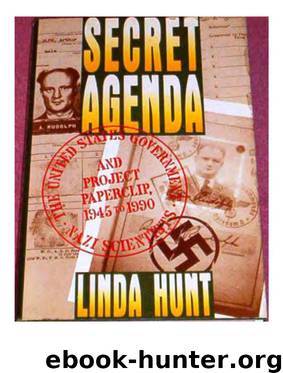Linda Hunt - Secret Agenda by The United States Government Nazi Scientists & Project Paperclip 1945 to 1990 (1990)

Author:The United States Government, Nazi Scientists & Project Paperclip, 1945 to 1990 (1990) [The United States Government, Nazi Scientists & Project Paperclip, 1945 to 1990 (1990)]
Language: deu
Format: epub
Published: 2006-05-06T17:03:14+00:00
On March 5 Clay sent Chamberlin the cable expressing his belief that war with the Russians
might be imminent. "Within the last few weeks, I have felt a subtle change in Soviet attitudes which I cannot define but which now gives me a feeling that it may come with dramatic suddenness," Clay told Chamberlin. The fact that Clay's telegram went on to say that his opinion was not supported by data or hard evidence went unnoticed.36
Clay's "war warning," as it later was referred to in the Pentagon, hit Washington like an earthquake. Within hours Chamberlin and the assistant secretary of defense had briefed Secretary of Defense James Forrestal on the contents of Clay's message. By evening the word had reached the top echelons of the Navy and Air Force. Within a few weeks Forrestal had a full-blown war scare on his hands. "Papers this morning," Forrestal wrote in his diary, "[are] full of rumors and portents of war."
The New York Times reported: "Top Military Men Urge U.S. To Arm to Show We Would Fight for Freedom," while Clay, trying to undo the damage, told reporters that he was "not the least bit apprehensive" and that "much too much is being made of this." Clay's comments went unheeded in Washington, where, during a Senate hearing, Secretary of the Navy John Sullivan announced that
submarines "belonging to no nation west of the ìron curtain' have been sighted off their shores."
Ignoring the lack of evidence, the Washington Times Herald headlined the disclosure: "Russian Subs Prowl West Coast Waters."37
The significant effect of Clay's cable on JIOA projects previously has been ignored by historians
and journalists who falsely assumed that the projects ended in the late 1940s. In fact, the resulting war scare escalated National Interest to such an extent that by 1950 U.S. intelligence was smuggling Eastern Europeans with false identities through immigration to Canada, where they were resettled.
Later one Royal Canadian Mounted Police officer was shocked to discover that six files of
incriminating information had been destroyed and replaced by a "false docket" on a Yugoslavian war crimes suspect who had been sent to Canada by U.S. intelligence. "I would be interested to know how the decision for destruction was reached for it is an action similar to the destruction of police files on Nazis in South America," the RCMP officer told his superior. British intelligence, which ran an identical project, also dumped their so-called "defectors" on Canada, as they had done with Nazi scientists. Canada's undersecretary of state recalled in November 1954 that Canada took in " `British exagents' who were not in fact defectors as originally understood." A Canadian government
investigation determined that many of these "ex-agents" were alleged war criminals or Nazi collaborators.38
The false war scare also invigorated Paperclip as the military received additional funds needed to keep the project going. Paperclip had been operating under a new policy that was supposed to
eliminate the project's procurement phase. But JIOA Director Bosquet Wev aptly pointed out in a
meeting that the JIOA never interpreted that to mean the end of Paperclip altogether.
Download
This site does not store any files on its server. We only index and link to content provided by other sites. Please contact the content providers to delete copyright contents if any and email us, we'll remove relevant links or contents immediately.
The Radium Girls by Kate Moore(11866)
100 Deadly Skills by Clint Emerson(4798)
Rise and Kill First by Ronen Bergman(4658)
The Templars by Dan Jones(4593)
The Doomsday Machine by Daniel Ellsberg(4375)
The Rape of Nanking by Iris Chang(4103)
Killing England by Bill O'Reilly(3927)
Hitler in Los Angeles by Steven J. Ross(3865)
Stalin by Stephen Kotkin(3826)
12 Strong by Doug Stanton(3456)
Hitler's Monsters by Eric Kurlander(3243)
Blood and Sand by Alex Von Tunzelmann(3101)
Darkest Hour by Anthony McCarten(3040)
The Code Book by Simon Singh(3022)
The Art of War Visualized by Jessica Hagy(2892)
Hitler's Flying Saucers: A Guide to German Flying Discs of the Second World War by Stevens Henry(2664)
Babylon's Ark by Lawrence Anthony(2488)
The Second World Wars by Victor Davis Hanson(2452)
Tobruk by Peter Fitzsimons(2416)
